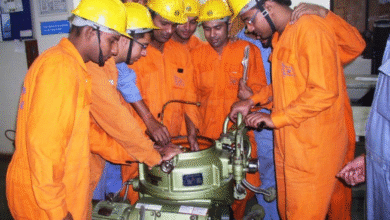Why a 5 axis CNC machine Is a Game Changer

In the fast-paced world of precision manufacturing, innovation isn’t optional—it’s essential. Industries such as aerospace, medical, automotive, and energy are demanding increasingly complex components with tight tolerances and shorter production times. One tool that meets these growing expectations is the 5 axis CNC machine. It stands as a symbol of high-performance machining, enabling manufacturers to create intricate parts with unmatched accuracy and efficiency.
This article provides a fresh perspective on what a 5 axis CNC machine is, how it works, and why it’s transforming manufacturing across the globe.
What Is a 5 axis CNC machine?
A 5 axis CNC machine is a type of computer-controlled tool that moves a cutting instrument or the workpiece along five different axes simultaneously. The three linear axes (X, Y, and Z) are the foundation of standard 3-axis machines, but a 5-axis system includes two additional rotational axes—often referred to as A and B or B and C.
This dynamic range of motion allows the cutting tool to approach the workpiece from any direction. This means it can handle more complex geometries, achieve superior surface finishes, and complete jobs in fewer steps compared to its 3-axis and 4-axis counterparts.
How Does It Work?
A 5 axis CNC machine operates through a synergy of hardware and software. The part geometry is first designed using CAD software, then translated into toolpaths via CAM software. These toolpaths include specific instructions on how the machine should move along its five axes to mill, drill, or cut the part.
The control unit sends commands to motors that coordinate the movements of the cutting tool and the table (or spindle). Because of the five axes, the tool can pivot or rotate during operation, accessing hard-to-reach angles and completing tasks that would otherwise require multiple setups.
Key Benefits of a 5 axis CNC machine
1. Single Setup Machining
The biggest efficiency booster in using a 5 axis CNC machine is its ability to complete complex jobs in one setup. This not only saves time but also reduces the risk of error introduced by repositioning the workpiece.
2. Higher Accuracy and Repeatability
Minimized handling translates to greater consistency. When manufacturing thousands of identical parts, accuracy is paramount, and this machine delivers.
3. Unmatched Flexibility
Parts with intricate contours, undercuts, and deep cavities are no challenge for a 5 axis CNC machine. Whether you’re crafting a titanium knee implant or an aircraft bracket, the machine adapts with ease.
4. Superior Surface Quality
Thanks to continuous tool engagement at optimal angles, the surface finish of parts is significantly improved. This often eliminates the need for additional post-processing.
5. Reduced Tool Wear
Better angles and uninterrupted cutting reduce stress on the tool. This increases tool life and reduces the frequency and cost of replacement.
Industry Use Cases
The 5 axis CNC machine is highly versatile and supports a wide range of industries:
- Aerospace: Produces high-precision parts such as turbine blades and structural components with complex curves.
- Medical: Essential for manufacturing implants, surgical tools, and dental components with exact dimensions.
- Automotive: Used for designing engine components, molds, and chassis parts that demand consistent quality.
- Defense: Ensures high tolerance for mission-critical military-grade hardware.
- Mold & Die: Speeds up the creation of complex injection molds and dies used in mass production.
See also: Technology in Commercial Cleaning: Innovations Shaping the Industry
Machine Configurations
There are several types of 5 axis CNC machine configurations, each suited for different needs:
• Head-Head Design
Both rotary axes are in the spindle head. Best for lightweight and intricate parts due to high-speed movement capabilities.
• Table-Table Design
Both rotary axes are on the work table, making this configuration more suitable for heavy workpieces due to its stability.
• Table-Head Design
A combination of both, this hybrid system is a balanced choice, providing both strength and flexibility.
Buying Guide: Choosing the Right 5 axis CNC machine
Before purchasing a 5 axis CNC machine, here are critical factors to evaluate:
• Workpiece Size and Weight
Choose a model that can handle your heaviest and largest components without compromising speed or accuracy.
• Material Compatibility
Ensure the spindle’s speed and torque match the materials you machine most often—whether it’s aluminum, steel, titanium, or composites.
• Controller Interface
Select a machine with an easy-to-learn interface (like FANUC, Siemens, or Heidenhain). A user-friendly system cuts down training time and errors.
• CAM Software Support
Your CAM system must be compatible with the machine. Popular programs include Fusion 360, Mastercam, and SolidCAM, which support 5-axis toolpaths and simulation.
• After-Sales Service
Check the availability of customer support, training, and spare parts from the manufacturer or local distributors.
New vs. Used: What Should You Buy?
✅ New Machines
- Best for long-term investment
- Equipped with latest tech and safety features
- Usually includes a warranty and training
✅ Used Machines
- Lower entry cost
- Good for workshops with limited budgets or prototyping needs
- Make sure it has been well-maintained and inspected
Training and Skill Requirements
Operating a 5 axis CNC machine demands specialized knowledge. Proper training is necessary for:
- Understanding toolpaths and multi-axis geometry
- Reading G-code specific to 5-axis movements
- Calibrating tools and workholding fixtures
- Troubleshooting and performing regular maintenance
Training can be sourced from the machine vendor, technical institutions, or online platforms.
Real-World Impact
Adopting a 5 axis CNC machine has tangible business benefits:
- Faster product development cycles
- Lower defect rates
- Better customer satisfaction
- Ability to bid on more complex and higher-value contracts
This makes the machine not only a tool for production but also a growth enabler for manufacturers looking to scale or diversify.
Conclusion
The 5 axis CNC machine is more than just a technological advancement—it’s a competitive advantage. It simplifies complex manufacturing, improves quality, and opens the door to producing parts that would otherwise be impossible to make. From saving time and reducing costs to enhancing flexibility and design freedom, the benefits are clear.
Whether you’re launching a startup machining shop or upgrading an established facility, investing in a 5 axis CNC machine positions your business for future success in an increasingly demanding market.
Unlock the power of precision. Embrace the efficiency of innovation. Let the 5 axis CNC machine redefine what’s possible in your production line.





